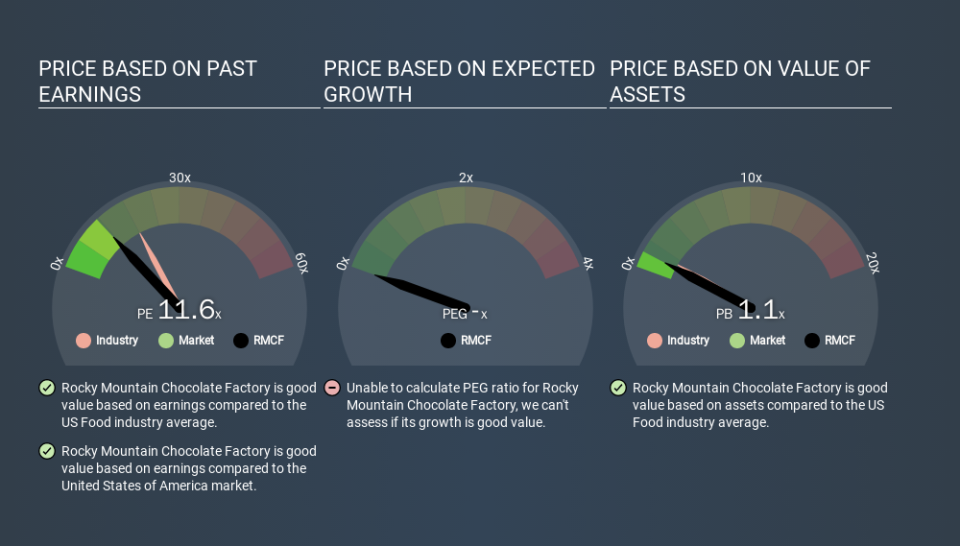What Is Rocky Mountain Chocolate Factory's (NASDAQ:RMCF) P/E Ratio After Its Share Price Tanked?

To the annoyance of some shareholders, Rocky Mountain Chocolate Factory (NASDAQ:RMCF) shares are down a considerable 55% in the last month. That drop has capped off a tough year for shareholders, with the share price down 58% in that time.
All else being equal, a share price drop should make a stock more attractive to potential investors. In the long term, share prices tend to follow earnings per share, but in the short term prices bounce around in response to short term factors (which are not always obvious). So, on certain occasions, long term focussed investors try to take advantage of pessimistic expectations to buy shares at a better price. Perhaps the simplest way to get a read on investors' expectations of a business is to look at its Price to Earnings Ratio (PE Ratio). A high P/E implies that investors have high expectations of what a company can achieve compared to a company with a low P/E ratio.
View our latest analysis for Rocky Mountain Chocolate Factory
Does Rocky Mountain Chocolate Factory Have A Relatively High Or Low P/E For Its Industry?
We can tell from its P/E ratio of 11.58 that sentiment around Rocky Mountain Chocolate Factory isn't particularly high. The image below shows that Rocky Mountain Chocolate Factory has a lower P/E than the average (18.3) P/E for companies in the food industry.
Rocky Mountain Chocolate Factory's P/E tells us that market participants think it will not fare as well as its peers in the same industry. Since the market seems unimpressed with Rocky Mountain Chocolate Factory, it's quite possible it could surprise on the upside. It is arguably worth checking if insiders are buying shares, because that might imply they believe the stock is undervalued.
How Growth Rates Impact P/E Ratios
Companies that shrink earnings per share quickly will rapidly decrease the 'E' in the equation. That means unless the share price falls, the P/E will increase in a few years. So while a stock may look cheap based on past earnings, it could be expensive based on future earnings.
Rocky Mountain Chocolate Factory's earnings per share fell by 17% in the last twelve months. And it has shrunk its earnings per share by 13% per year over the last five years. This might lead to muted expectations.
Don't Forget: The P/E Does Not Account For Debt or Bank Deposits
The 'Price' in P/E reflects the market capitalization of the company. So it won't reflect the advantage of cash, or disadvantage of debt. The exact same company would hypothetically deserve a higher P/E ratio if it had a strong balance sheet, than if it had a weak one with lots of debt, because a cashed up company can spend on growth.
Such spending might be good or bad, overall, but the key point here is that you need to look at debt to understand the P/E ratio in context.
Rocky Mountain Chocolate Factory's Balance Sheet
With net cash of US$5.3m, Rocky Mountain Chocolate Factory has a very strong balance sheet, which may be important for its business. Having said that, at 24% of its market capitalization the cash hoard would contribute towards a higher P/E ratio.
The Bottom Line On Rocky Mountain Chocolate Factory's P/E Ratio
Rocky Mountain Chocolate Factory's P/E is 11.6 which is about average (11.8) in the US market. While the absence of growth in the last year is probably causing a degree of pessimism, the healthy balance sheet means the company retains potential for future growth. So it's not surprising to see it trade on a P/E roughly in line with the market. Given Rocky Mountain Chocolate Factory's P/E ratio has declined from 25.9 to 11.6 in the last month, we know for sure that the market is significantly less confident about the business today, than it was back then. For those who don't like to trade against momentum, that could be a warning sign, but a contrarian investor might want to take a closer look.
Investors should be looking to buy stocks that the market is wrong about. If the reality for a company is not as bad as the P/E ratio indicates, then the share price should increase as the market realizes this. We don't have analyst forecasts, but shareholders might want to examine this detailed historical graph of earnings, revenue and cash flow.
Of course, you might find a fantastic investment by looking at a few good candidates. So take a peek at this free list of companies with modest (or no) debt, trading on a P/E below 20.
If you spot an error that warrants correction, please contact the editor at editorial-team@simplywallst.com. This article by Simply Wall St is general in nature. It does not constitute a recommendation to buy or sell any stock, and does not take account of your objectives, or your financial situation. Simply Wall St has no position in the stocks mentioned.
We aim to bring you long-term focused research analysis driven by fundamental data. Note that our analysis may not factor in the latest price-sensitive company announcements or qualitative material. Thank you for reading.

